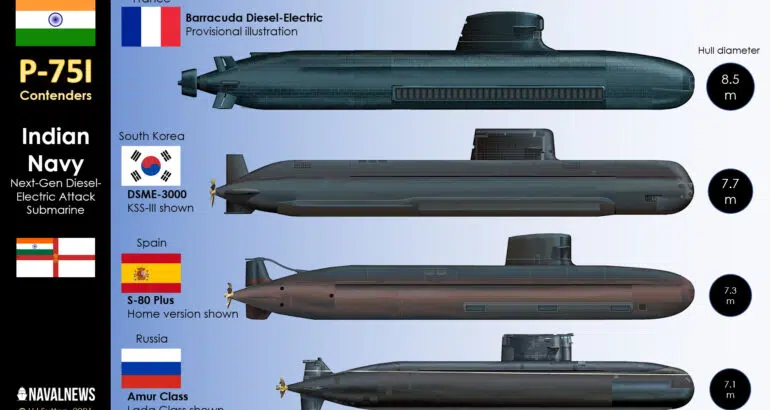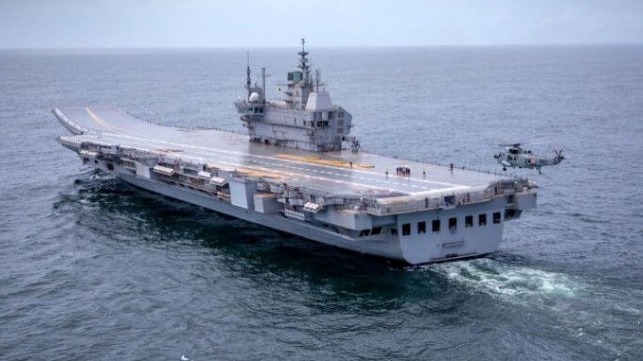Marinha Indiana
Moderador: Conselho de Moderação
- FCarvalho
- Sênior

- Mensagens: 37933
- Registrado em: Sex Mai 02, 2003 6:55 pm
- Localização: Manaus
- Agradeceu: 5733 vezes
- Agradeceram: 3270 vezes
Re: Marinha Indiana
Não é um navio bonito, ou sequer de linhas elegantes, mas os indianos estão realmente de parabéns pela insistência no projeto do Vycrant.
Pode fazer-nos pensar daqui alguns anos.
A ver agora o que vão colocar para voar neles, além dos Mig-29K que possuem.
Pode fazer-nos pensar daqui alguns anos.
A ver agora o que vão colocar para voar neles, além dos Mig-29K que possuem.
Carpe Diem
- P44
- Sênior

- Mensagens: 55278
- Registrado em: Ter Dez 07, 2004 6:34 am
- Localização: O raio que vos parta
- Agradeceu: 2755 vezes
- Agradeceram: 2436 vezes
Re: Marinha Indiana

The 4 Submarines Competing For The Indian Navy’s P-75I Program
The Indian Navy's P-75I submarines will be larger and much more potent than the Kalvari Class now entering service. They will be the bedrock of India's submarine fleet at a time when the strategic focus is leaning towards China as well as the traditional adversary, Pakistan. There are 4 contenders.
H I Sutton 14 Oct 2021
There are four contenders for the Indian navy’s next-generation P75I submarine. They are currently submitting design proposals to the Indian Government. Whatever the outcome the boats are expected to all be built in India. So the deal will factor in political and industrial considerations as well as naval requirements.
The four contenders are the Barracuda from France, the S-80-Plus from Spain, DSME-3000 from South Korea and Amur design from Russia. Germany had also been a contender but recently said that they dropped out.
All of the contenders have their merits and it is likely to be a tough choice for the Indian Navy. Below we outline the different designs.
The Indian Navy’s detailed requirements have not been shared. Based on reports and analysis of their current capabilities, investments and threat focuses, two things seem sure. The first is that P75I will have AIP (air independent power). The second is that they would prefer a VLS to launch Brahmos anti-ship missiles. Taken together, the P75I will have to be much larger than previous Indian navy conventional submarines.
Both the AIP and VLS will present challenges and difficult decisions. Like all major submarine projects, trade-offs will have to get made. India has developed its own fuel cell AIP which it is planning to fit to the current French-designed Kalvari Class (Scorpene type). This is a logical choice for the P75I also, particularly from the perspective of indigenous industry. However the Indian Navy is likely to be very interested in the AIP already available with the designs. Incorporating the local AIP would increase development risks, and close off opportunities to access better AIP systems.
The VLS will be a challenge because all the contenders are relatively small boats. It is unclear how dependent the contract will be on a VLS, or whether alternative missile options will be considered.
1. Barracuda Class Submarine
France’s Naval Group is believed to be offering a diesel-electric version of their Barracuda nuclear submarine. The nuclear version is already in service with the French Navy (Marine Nationale) as the Suffren Class. Being from the same lineage as the Kalvari Class currently being built in India, it can be seen as a strong contender.
The diesel-electric version could have some design features from the SMX-3.0 design. This was exhibited at DEFEXPO in India in 2020. This may include the sail-mounted hydroplanes (as opposed to hull mounted on Suffren) and AIP. The French AIP system uses fuel-cells with a diesel reformer to eliminate the need for onboard hydrogen storage. It has been shore tested for years.
Perhaps the largest design advantage of the Barracuda is simply its size. The hull diameter of around 8.5 meters is the largest of the competitors. This should make it comparatively less challenging to fit a VLS, even with the massive Brahmos missile. The related SMX Ocean concept already has a VLS, and the baseline Barracuda class can anyway launch MdCN land-attack cruise missiles.
Other noteworthy features of the French design are likely to include X-form rudders and a pump-jet. This latter feature may also be of interest in India’s nuclear submarine projects.
We can speculate that French nuclear submarine technologies and/or access to extra-large uncrewed underwater vehicle (XLUUV) technologies, may also be a factor. Naval Group recently revealed that they have had an XLUUV demonstrator in the water since last year.
2. DSME-3000, South Korea’s Missile Submarine
South Korea has recently spread its wings and entered the submarine export game, selling boats to Indonesia. They are understood to be proposing an export version of their home-grown KSS-III design. This is a relatively large non-nuclear boat, likely second only to the Barracuda.
The type comes with German based fuel-cell AIP. The layout, with a hull section essentially dedicated to AIP, suggests that it would not be too challenging to swap it for the Indian alternative.
And South Korea is ahead of most countries in the race to fit lithium-base battery technology to submarines. This promises to extend the endurance of submarines when running on batterie. Naturally this may be attractive to the Indian Navy, even potentially diminishing the importance of AIP.
Its differentiating feature is that it already comes with a six or ten round VLS. In South Korean service this is expected to carry the Hyunmoo 4-4 missile, which is roughly equivalent to India’s K-15 Sagarika but without a nuclear option. While exact dimensions and weights are not available, this at least implies that it could accommodate the similarly sized Brahmos.
Carrying a VLS in such a small submarine likely needs some trade-offs, like fewer weapons slots in the regular torpedo room. But overall the South Korean design seems balanced and highly capable.
3. Spain’s New Entrant: S-80 Plus
Another new country to submarine exports, Spain’s Navantia is offering a variant of their latest S-80 plus design. This is a larger boat than the Scorpene design (per India’s Kalvari Class), but smaller than the South Korean or French options.
The AIP is a fuel-cell system with bio-ethanol reformer. So like the French system there is no need for hydrogen storage. Currently Spain’s S-80 Plus boats are not running with AIP, but the system is being tested and should go to sea in the next few years.
It is unclear whether Navantia is proposing a VLS. The design was always intended to be compatible with land-attack cruise missiles shot from the torpedo tubes.
4. The Russian Option: Amur
Essentially the export versions of the Lada Class, the Amur family of submarines has been offered for several years. Russia already has strong ties with the Indian Navy and some related Kilo Class submarines are still in their service. The Amur shares some lineage to the Kilo but features a single-hull configuration.
Despite having the smallest hull diameter of the contenders (1.5 meters less than the Barracuda), design models have frequently shown a VLS. This seems to have been for smaller Kalibr sized weapons rather than the Brahmos however.
Another challenge for the Amur designs could be AIP. Russia has yet to develop an AIP system for its Lada Class. Possibly the Indian AIP system is key to the proposal.
Like France, Russia may be seen as having a ‘home advantage’ because of the strong historic relationship. There have been reports that Russia views this as an opportunity to joint-develop the next generation of non-nuclear submarine. How this sits with other reports of the same thing with China remains unclear.
https://www.navalnews.com/naval-news/20 ... i-program/
Triste sina ter nascido português 
- P44
- Sênior

- Mensagens: 55278
- Registrado em: Ter Dez 07, 2004 6:34 am
- Localização: O raio que vos parta
- Agradeceu: 2755 vezes
- Agradeceram: 2436 vezes
Re: Marinha Indiana
Video: India’s First Domestically-Built Carrier is Out on Sea Trials

PUBLISHED OCT 26, 2021 7:30 PM BY THE MARITIME EXECUTIVE
India’s first domestically built aircraft carrier, the Vikrant, departed for its second round of sea trails as the vessel prepares for delivery. More than 20 years since planning first began, and beset by numerous construction delays, the aircraft carrier is now expected to be commissioned in 2022, possibly coordinated with the government’s plans to celebrate India’s 75 years of independence in 2022.
Planning for the Vikrant reportedly started in 1999 with construction beginning a decade later. Built at the Cochin Shipyard, the vessel is also known as Indigenous Aircraft Carrier 1 becoming an object of pride for the nation which currently only has one aircraft carrier, a Russian-built vessel. The government is celebrating that nearly three-quarters of the Vikrant and her equipment was built in India.
The Vikrant is approximately 860 feet long with a beam of over 200 feet and a height of 193 feet to the top of the conning tower. She will carry a complement of nearly 1,700 including 196 officers.
India chose to build a mid-sized carrier which when completed will be approximately 45,000 tons full load. She is outfitted with a high degree of automation for navigation as well as operations and will be able to accommodate both fixed-wing and rotary aircraft. Her initial air wing will include MIG fighter jets, helicopters, and early warning system helicopters.
The Vikrant features a STIBAR design with a ski jump at the front of the flight deck for launching aircraft under their own power. It uses a STOBAR design, short take-off, barrier arrested recovery, system.
Power for the aircraft carrier is from four General Electric gas turbines and two Elecon COGAG, combined gas turbine gearbox driving two shafts. The vessel is designed to operate at top speeds of between 28 and 30 knots with a maximum range of 7,500 to 8,000 nautical miles at a speed of 18 knots.
The Vikrant undertook its first sea trials in August 2021, pronounced a success by the Indian Navy. The vessel departed on October 24 for its second round of trials.
https://www.maritime-executive.com/arti ... sea-trials

PUBLISHED OCT 26, 2021 7:30 PM BY THE MARITIME EXECUTIVE
India’s first domestically built aircraft carrier, the Vikrant, departed for its second round of sea trails as the vessel prepares for delivery. More than 20 years since planning first began, and beset by numerous construction delays, the aircraft carrier is now expected to be commissioned in 2022, possibly coordinated with the government’s plans to celebrate India’s 75 years of independence in 2022.
Planning for the Vikrant reportedly started in 1999 with construction beginning a decade later. Built at the Cochin Shipyard, the vessel is also known as Indigenous Aircraft Carrier 1 becoming an object of pride for the nation which currently only has one aircraft carrier, a Russian-built vessel. The government is celebrating that nearly three-quarters of the Vikrant and her equipment was built in India.
The Vikrant is approximately 860 feet long with a beam of over 200 feet and a height of 193 feet to the top of the conning tower. She will carry a complement of nearly 1,700 including 196 officers.
India chose to build a mid-sized carrier which when completed will be approximately 45,000 tons full load. She is outfitted with a high degree of automation for navigation as well as operations and will be able to accommodate both fixed-wing and rotary aircraft. Her initial air wing will include MIG fighter jets, helicopters, and early warning system helicopters.
The Vikrant features a STIBAR design with a ski jump at the front of the flight deck for launching aircraft under their own power. It uses a STOBAR design, short take-off, barrier arrested recovery, system.
Power for the aircraft carrier is from four General Electric gas turbines and two Elecon COGAG, combined gas turbine gearbox driving two shafts. The vessel is designed to operate at top speeds of between 28 and 30 knots with a maximum range of 7,500 to 8,000 nautical miles at a speed of 18 knots.
The Vikrant undertook its first sea trials in August 2021, pronounced a success by the Indian Navy. The vessel departed on October 24 for its second round of trials.
https://www.maritime-executive.com/arti ... sea-trials
Triste sina ter nascido português 
- FCarvalho
- Sênior

- Mensagens: 37933
- Registrado em: Sex Mai 02, 2003 6:55 pm
- Localização: Manaus
- Agradeceu: 5733 vezes
- Agradeceram: 3270 vezes
Re: Marinha Indiana
Muito interessante essa opção convencional do Barracuda francês. É algo que deveria ser pensado aqui como uma alternativa no futuro para a classe seguinte à Riachuelo de sub convencionais da MB. E como é francês, pode ser que seja algo favorável, dado que eles já estão por aqui mesmo. Desenvolver uma versão convencional do subnuc não deve ser tão complicado que não possa ser feito.
Já o INS Vicran, não é por nada não, mas ô bicho feio esse navio.
Já o INS Vicran, não é por nada não, mas ô bicho feio esse navio.
Carpe Diem
- J.Ricardo
- Sênior

- Mensagens: 7598
- Registrado em: Qui Jan 13, 2005 1:44 pm
- Agradeceu: 2552 vezes
- Agradeceram: 1027 vezes
Re: Marinha Indiana
Quando for pensado em um substituto para os Riachuelo muita água vai ter passado por baixo da ponte, novas tecnologias, novos conceitos, novos designers...
Não temais ímpias falanges,
Que apresentam face hostil,
Vossos peitos, vossos braços,
São muralhas do Brasil!
Que apresentam face hostil,
Vossos peitos, vossos braços,
São muralhas do Brasil!
- FCarvalho
- Sênior

- Mensagens: 37933
- Registrado em: Sex Mai 02, 2003 6:55 pm
- Localização: Manaus
- Agradeceu: 5733 vezes
- Agradeceram: 3270 vezes
Re: Marinha Indiana
A questão é que precisamos de soluções para ontem a fim de não ver todo o nosso suado corinho de rato parar em mais um buraco da negligência política com os projetos da Defesa
Carpe Diem
- P44
- Sênior

- Mensagens: 55278
- Registrado em: Ter Dez 07, 2004 6:34 am
- Localização: O raio que vos parta
- Agradeceu: 2755 vezes
- Agradeceram: 2436 vezes
- knigh7
- Sênior

- Mensagens: 18737
- Registrado em: Ter Nov 06, 2007 12:54 am
- Localização: S J do Rio Preto-SP
- Agradeceu: 1962 vezes
- Agradeceram: 2489 vezes
- Viking
- Avançado

- Mensagens: 549
- Registrado em: Qui Fev 13, 2020 4:39 pm
- Agradeceu: 1 vez
- Agradeceram: 333 vezes
Re: Marinha Indiana
Prezado J. Ricardo
Entendi que a classe Barracuda versão SSK e para ontem, ou seja construção em continuidade ao 4 classe Riachuelo e não substituição dos mesmos. Caso não haja continuidade imediata na produção de pelo menos mais um lote de 4 SSK e a produção futura da ICN fique limitada ao SN 10 todo o complexo industrial de Itaguaí vai se transformar em um grande elefante branco e a credibilidade da MB será jogada na lata do lixo.
Sds
- FCarvalho
- Sênior

- Mensagens: 37933
- Registrado em: Sex Mai 02, 2003 6:55 pm
- Localização: Manaus
- Agradeceu: 5733 vezes
- Agradeceram: 3270 vezes
Re: Marinha Indiana
Não não há tempo e meios para desenvolvermos uma versão convencional do nosso subnuc em curto e médio prazo, então a construção de novos Classe Riachuelo é algo não só impositivo se não quisermos jogar todo o investimento feito até aqui fora, como indispensável à continuidade da capacidade de manutenção do que se está construindo até o presente momento, já que os sub da classe Riachuelo irão precisar serem atendidos neste sentido quando de seus PMG e/ou paradas periódicas.
Para uma fase posterior quando e se o Álvaro Alberto passar de um único navio da classe pode-se pensar em desdobramentos sobre o uso de seu projeto como ponto de partida para uma nova classe de submarinos convencionais.
Aliás, quanto ao navio indiano acima talvez seja uma opção para conversar com os indianos no futuro a longo prazo.
Por fim, Operações Passex com Índia, Rússia e China deveria ser algo a se pensar aqui no Atlântico Sul, mas somente quando as FCT estiverem disponíveis. Os atuais navios já deram o que tinham, e não seria lúcido colocá-los em situação de exigência operacional quando até mantê-los funcionando já se tornou uma situação mais que vexatória.
Para uma fase posterior quando e se o Álvaro Alberto passar de um único navio da classe pode-se pensar em desdobramentos sobre o uso de seu projeto como ponto de partida para uma nova classe de submarinos convencionais.
Aliás, quanto ao navio indiano acima talvez seja uma opção para conversar com os indianos no futuro a longo prazo.
Por fim, Operações Passex com Índia, Rússia e China deveria ser algo a se pensar aqui no Atlântico Sul, mas somente quando as FCT estiverem disponíveis. Os atuais navios já deram o que tinham, e não seria lúcido colocá-los em situação de exigência operacional quando até mantê-los funcionando já se tornou uma situação mais que vexatória.
Carpe Diem
- Viking
- Avançado

- Mensagens: 549
- Registrado em: Qui Fev 13, 2020 4:39 pm
- Agradeceu: 1 vez
- Agradeceram: 333 vezes
Re: Marinha Indiana
Indian Navy to launch the sixth Kalvari-class submarine Vagsheer
https://www.navyrecognition.com/index.p ... sheer.html
https://www.navyrecognition.com/index.p ... sheer.html




